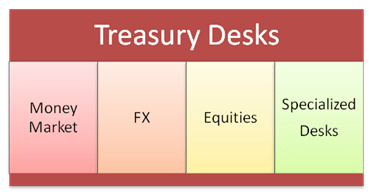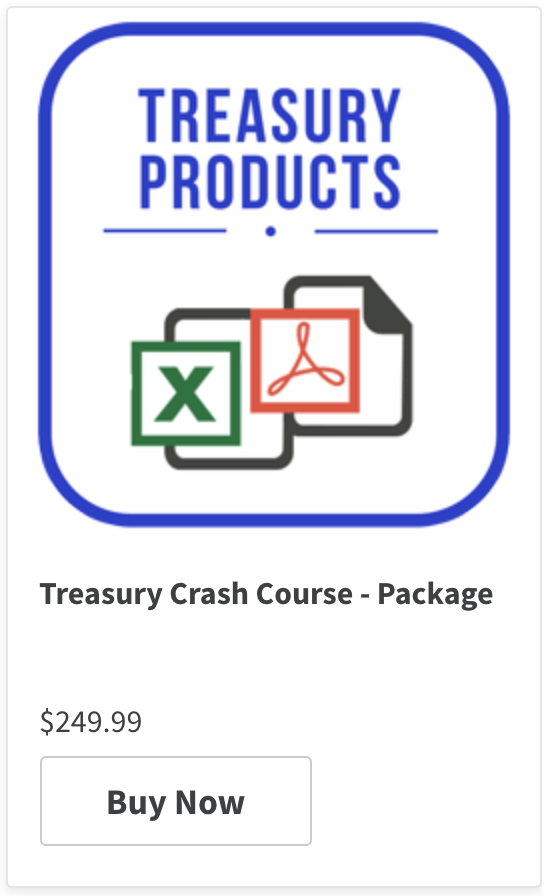We present ten short lessons to help with your treasury training. The lessons will give you an introduction to treasury terminology and functions.
1. What does the Treasury group do?
A treasury group is a specialized function that exists within banks and large corporations. The group is responsible for the following activities:
- Buying and selling of foreign exchange currencies in a centralized fashion.
- Borrowing to meet liquidity requirements as well as lending and placing excess cash to ensure all resources are usefully deployed.
- Depending on the treasury group structure, they may also be responsible for managing and growing the investment portfolio. This includes bonds, shares and any other financial securities.
The functions are centralized because buying and selling currencies and borrowing and lending money requires a certain skill set and infrastructure. Rather than distributing it across an organization, it is more efficient to create a dedicated group to support it.
2. What desks does the group have and what do they do?

From the figure above we see that the Treasury group consists of:
a. Money market desk
A money market desk is responsible for funding and lending activities in the local currency. It provides these services through the use of a number of products and relationships. These include:
- outright sale and purchase of securities,
- deposits and placements,
- repo and reverse repo transactions,
- borrowings and lendings, etc.
We will look at the common money market products and trades in treasury training lesson 4.
b. FX desk
This desk is responsible for funding and lending activities in foreign currencies using a number of products:
- Spot and forward transactions,
- FX swap transactions,
- Foreign Bill Purchase,
- Bill discounting,
- Remittance,
- Encashment,
- FX Placements and borrowings, etc.
These include inter-bank transactions as well as trades carried out with Treasury Market Unit (TMU) customers. We will look at the common FX products and trades in treasury training lesson 3.
c. Equity desk
An equity desk is responsible for trades on the stock market. These include ready trades as well as futures and margin lending transactions.
d. Specialized desks
Specialized Treasury desks may include such desk as:
- An Asset Liability Management Desk
- A derivatives desk that sells advanced solutions for client specific needs
- A corporate sales desk. This desk is responsible for facilitating deals with clients whose transactions and trades exceed certain limits. Also, for supporting the branch network and the corporate banking teams
- And an internal capital management or proprietary trading desk. This desk invests excess cash and capital for trading and profit generation purposes.
We will learn more about the ALM, Corporate & Proprietary desks treasury training lessons 5, 6 & 7 below.
3. What are the primary FX (Foreign Exchange) products?
Primary FX products covered in our treasury training include:
a. FX Ready
Treasury usually uses FX ready trades for hedging and speculation in foreign exchange. Corporates widely use these simplest and most common foreign exchange transactions to cover their receivables and payables. It involves the prompt exchange of one currency against another on the international or local market. Settlement occurs within two business days after the transaction.
b. FX Forward
Treasury uses FX Forward trades usually for hedging and speculation in foreign exchange. These involve the exchange of different currencies with the exchange rate set at the present date and the maturity at some future date. Forward agreements guarantee the fixed exchange rate agreed at the inception of the agreement for a purchase or sale of a currency at a future date.
c. FX Swap
A transaction in which two contractual parties agree to exchange a specified amount of one currency for another currency on future dates at a fixed price. Cash flows that can be exchanged are principal and interest (cross-currency swap), interest only (coupon-only swap) and principal only (principal-only swap).
d. FX Placements/ Borrowings
Similar to the MM Call lending/ borrowing transaction (given below) but denominated in Foreign Currency. Mark-up calculations depend upon the day count of the currency of placement/borrowing.
e. FX Miscellaneous:
Transactions used to allow for any adjustments to the NOSTRO accounts and to transfer funds from one NOSTRO to another.
h. FX TMU – Import/ Export/ Remittance/ Encashment
Encashment are spot deals with Value dates equal to the deal date. The FX TMU Imports, exports and remittance transactions can either be spot deals or forward transactions.
i. FX TMU – Foreign Bill Purchase (Bill Discounting)
We generally associate a bill Discounting transaction with an Import or Export payment. The customer will approach the bank’s treasury and request them to provide him with the local currency equivalent of the amount due now against the foreign currency that he will receive on the settlement date. On the settlement date whenever the FX currency amount comes in it is converted and sold to cover and discharge the liability of the customer.
j. FX TMU – Close Out/ Take Up
A TMU transaction where a foreign bill purchased may be closed out (read matured) prior to its scheduled maturity if the amount due comes in earlier.
4. What are the primary MM (Money Market, Fixed Income) products?
Primary MM products covered in our treasury training include:
a. Call/ Clean/ Placements
Forms of unsecured lending also known as clean lending or placements.
b. Repo/ Reverse Repo
A repurchase agreement is a form of short-term borrowing. The dealer sells the securities to investors for cash (usually on an overnight basis). He then buys them back on a pre-determined date (usually the following day) at a pre-determined price. The pre-determined price reflects the cash amount (i.e. the loan) and interest. These are determined based on the credit quality of the asset and the market rate of interest. For the party selling the security (and agreeing to repurchase it in the future), it is a repo. For the other party to the transaction, (buying the security and agreeing to sell in the future) it is a reverse repurchase agreement. Treasury uses these instruments for liquidity and cash flow management.
c. Sale against Reverse Repo (SARR)
Short selling is when a trader sells a security that they do not own or where they deliver borrowed securities on the sale. The person executing a short sale anticipates that prices will fall and that they will profit or gain on the transaction by being able to buy back the security at a lower price than the rate at which they sold it for.
d. Outright purchase/ sale
The purchase and sale of money market securities such as bonds are carried out for:
- Investment purposes
- Liquidity management
- To take advantage of arbitrage opportunities.
e. Inter branch ticket
The funds transfer is from one branch of the bank to another branch of the same bank.
5. What does the ALM desk do?
The ALM desk is responsible for managing liquidity and the maturity profile of assets and liabilities across the entire institution.
6. What does the corporate desk do?
A corporate sales desk is responsible for:
- facilitating deals with clients whose transactions and trades exceed certain limits,
- supporting the branch network and the corporate banking teams.
7. What does the proprietary desk do?
An internal capital management or proprietary trading desk invests excess cash and capital for trading and profit generation purposes. Proprietary (or prop) trading is the means by which the bank trades stocks, bonds, options, commodities, derivatives or other financial instruments for its own account. That is, for its own profit rather than trading on behalf of its customers. It involves active position taking with a view to capital gain.
These desks work in isolation from those processing trades on behalf of the bank’s clients. The objective of these desks is to earn profits above those that could be earned in their normal market-making trades. Another reason to keep the trading desk separate from the other desks is to avoid conflicts of interest. These are situations where the prop desk’s trades could harm the bank’s customers’ interests.
8. Why is the Forward price different from the spot price?
The forward price is what you will pay on a forward contract today for delivery made some time in the future. It is different from the spot price, i.e. the price of the asset today. A forward price takes into account:
- the time value of money,
- the remaining duration of the contract,
- dividends/ yields that are due in the future if you are dealing with income bearing securities, or
- cost of carry if you are dealing with a commodity as an underlying, or
- the foreign currencies interest rate if the underlying is a foreign-denominated asset.
9. Why is a rate only valid for a limited time?
The rate quoted on a deal is only valid for a limited time primarily because prices change every second. Each desk or layer adds its spread on the base rate. While there is room in that spread for some movement, a rate needs to be locked down by creating the required position.
10. Why do I need a credit limit for a client to deal in more advanced products?
A credit limit requirement is to to enable the trade with a given counterparty. Advanced products also are customized and specialized structured products. They expose the Treasury function to a greater level of risk from counterparty default. The limits ensure that transactions are within the risk tolerances acceptable to and the risk appetite of the function.
Limits are a function of:
- volatility in markets,
- the level and volume of trades carried out,
- the maturities on the underlying securities,
- the credit assessment of a given counterparty and
- changing risk tolerances.
For more topics on Treasury training see our “Treasury Management and Operations Course” page.

